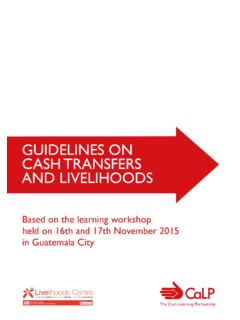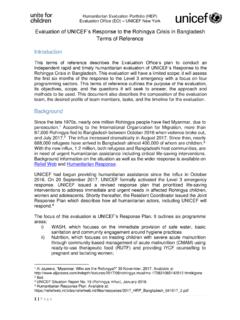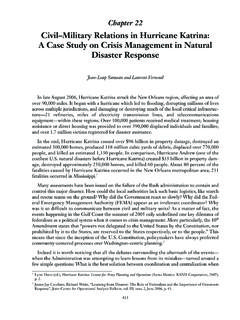Transcription of MINIMUM STANDARD FOR MARKET ANALYSIS …
1 The Cash learning PartnershipMINIMUM STANDARD FOR MARKET ANALYSIS (MISMA)Photo: Rajendra Shaw/Oxfam3 MINIMUM STANDARD FOR MARKET ANALYSIS (MISMA)ACKNOWLEDGEMENTSThis document was written by Helene Juillard (independent consultant) under the technical guidance and coordination of Isabelle Pelly (Technical Coordinator, CaLP), with funding from the Swiss government. It is a product of consultation with several agencies and more than 10 individuals across sectors and governance levels, including Emily Sloane (IRC), Karri Byrne (independent consultant), Sandy Walton (Ellery) and Leonie Tax (ACAPS).
2 It has benefited from the experience shared by the representatives of the other Humanitarian standards Partners including Sphere, MINIMUM Economic Recovery standards and the Livestock emergency Guidelines and standards . A previous version of the MINIMUM STANDARD for MARKET ANALYSIS , published in 2013 under the name MINIMUM Requirements for MARKET ANALYSIS , was written by Lois Austin and Sebastien Chessex. Cover photo: Tom Pietrasik/Oxfam 4 MINIMUM STANDARD FOR MARKET ANALYSIS (MISMA)TABLE OF CONTENTSA cknowledgements 3 The MINIMUM STANDARD at a Gglance 5 List of Abbreviations 6 Key Terms 6 Introduction 7 The Misma: A Humanitarian standards Partner 8 Purpose and scope 10 Target audience 11 How to use the MISMA 11 When to use the MISMA 11 Conforming with the MISMA 12 Dissemination and communication 12 Key Action 1.
3 Scope 13 Steps 13 Key indicators 13 Guidance notes 13 What to avoid 15 Key Action 2: MARKET ANALYSIS Team 16 Steps 16 Key indicators 16 Guidance notes 16 Key Action 3: Data Collection 17 Steps 17 Key indicators 17 Guidance notes 17 What to avoid 22 Key Action 4: ANALYSIS 23 Steps 23 Key indicators 23 Guidance notes 23 What to avoid 25 Key action 5: MARKET monitoring 26 Steps 26 Key indicators 26 Guidance notes 27 What to avoid 28 Annexes 29 Annex 1: MARKET ANALYSIS Checklist 29 Annex 2: Existing MARKET ANALYSIS and assessment tools in emergencies 32 Annex 3: Programme decisions and guiding questions 33 Annex 4: Bibliography 34 List of figures and tablesFigure 1: The STANDARD , key actions (KA) and indicators 5 Figure 2.
4 MARKET based programming framework 8 Figure 3: The Humanitarian standards Partnership 10 Figure 4: A framework for MARKET ANALYSIS 14 Table 1: Types and sources of information required for MARKET assessment 18 Table 2: Collecting the appropriate data from the relevant MARKET stakeholders 19 Table 3: Data collection methods 21 Table 4: Criteria to determine the level of ANALYSIS 24 Table 5: Suggested MARKET indicators per delivery modality type 27 Table A1: MISMA key action checklist 29 Table A2: Comparison of humanitarian MARKET ANALYSIS tools 32 Table A3: Questions for programme- related decisions 33C5 MINIMUM STANDARD FOR MARKET ANALYSIS (MISMA) MARKET ANALYSIS is a key component of response ANALYSIS .
5 It informs the design and implementation of appropriate interventions using and supporting local marketsScope: Define the analytical and geographic scope of the assessmentMarket ANALYSIS team: Build a competent and knowledgeable team for data collection and ANALYSIS The MARKET ANALYSIS is conducted as part of the response design or a contingency planning exercise. The MARKET ANALYSIS is driven by clear objectives and key questions within a delineated scope. The MARKET ANALYSIS includes an assessment of overall MARKET functionality. The selection of critical markets is driven by identified household needs and vulnerabilities.
6 The different needs, strengths and vulnerabilities of all target groups are used to determine the scope of the assessment. The different team members have complementary skills and local knowledge, and the team is gender balanced. Each team member has clearly defined roles and collection:Use data collection methods and information sources of sufficient quality The data is drawn from multiple sources, representative of different MARKET stakeholders. The data collection methods are participatory and sensitive to the biases of informants and interest groups. The methods used do not put the security of those conducting or responding to the survey at risk.
7 KA3 ANALYSIS : Use MARKET ANALYSIS to adequately inform programme design and achieve programme objectives The level of ANALYSIS is adequately defined based on the information needed, the resources available and the risk that the intended response will harm the MARKET . Data is interpreted within its level of representation. The data used for the ANALYSIS is triangulated, and is drawn from multiple sources. Programme design decisions are based on the findings of the MARKET monitoring: Use MARKET monitoring to review assessment findings and enable programme adaptations when needed The programme monitoring framework includes MARKET -related indicators that, at a MINIMUM , capture the price and volume of transactions.
8 MARKET monitoring is planned, organised and budgeted. MARKET monitoring contributes to the follow-up of interventions achievements. Programmatic changes are made, when required, on the basis of MARKET monitoring MINIMUM STANDARD AT A GLANCE Figure 1: The STANDARD , key actions (KA) and indicatorsC6 MINIMUM STANDARD FOR MARKET ANALYSIS (MISMA)LIST OF ABBREVIATIONSCaLPCash learning PartnershipCFWCash for workCTP Cash transfer programmingEMMAE mergency MARKET Mapping and AnalysisEWSE arly warning systemFEWSNETF amine Early Warning System Network HSPH umanitarian standards PartnershipMAGM arket assessment guidanceMBPM arket-based programmingMISMAM inimum STANDARD for MARKET AnalysisMSMAM ulti-sectoral MARKET analysisPCMAPre-crisis MARKET ANALYSIS (previously PCMMA)
9 RAMR apid Assessment for Markets GuidanceKEY TERMS1 Cash transfer programming: CTP refers to all programs where cash (or vouchers for goods or services) is directly provided to beneficiaries. In the context of humanitarian assistance the term is used to refer to the provision of cash or vouchers given to individuals, household or community recipients; not to governments or other state actors. CTP covers all modalities of cash based assistance, including vouchers. This excludes remittances and microfinance in humanitarian interventions (although microfinance and money transfer institutions may be used for the actual delivery of cash).
10 The term can be used interchangeably with Cash Based Interventions and Cash Based : a system of exchange between two or more actors or players. The exchange can be for goods or services, or for money and can take place in a physical space or through virtual media such as the internet. Markets are sometimes defined by the forces of supply and demand, rather than geographical location imported cereals make up 40% of the MARKET . MARKET ANALYSIS : The process of understanding the key features and characteristics of a MARKET system based on the data collected during the assessment.








